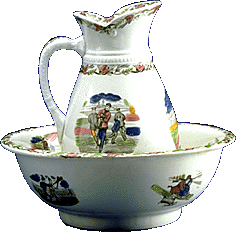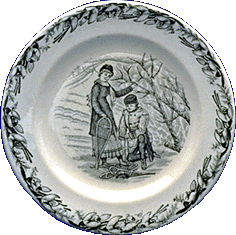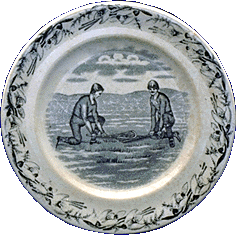UNDERGLAZE TRANSFER-PRINTED EARTHENWARE (part 2)
The best known of the Canadian scenes were taken by Staffordshire potters from the work of W.H. Bartlett, an English topographical artist who was in Canada in the 1830s. Bartlett travelled in Europe, Asia and North America, making sketches as he went. They were engraved and published in London in what would today be called coffee-table books. The book illustrating Canadian scenery was advertised in Canada at the beginning of the 1840s. A few years later a Halifax importer was taking orders for the Canadian views on tableware. In all, some half-dozen Staffordshire potters included Bartlett's Canadian scenes in the outpouring of topographical views decorating their earthenwares.
 |
 |
Platter, circa 1845
Maker: Podmore, Walker & Co.
Staffordshire, England
Pattern Name: "British America"
View of "Kingston, Lake Ontario"
Canadian Museum of Civilization
Cat. no. 980.111.299
Photo S97-17901, CD2004-877 |
|
Canadian scenes on British earthenware were offered in a wide range of colours. Blue was almost always one of the options, but the blue itself could vary. A deep, dark blue (not to be confused with the later "flowing blue") became popular with North American customers. "Dark Blue Earthenware" was advertised in Montreal in the 1820s. It was the shade of blue chosen by Enoch Wood, a Staffordshire potter with a strong North American trade, for scenes of Canada's Quebec City, Montmorency Falls, and Table Rock, Niagara. Wood's Canadian scenes were not intended for the Canadian market; however, they were included in a long series of United States views made for sale in that country and marked with the American eagle and motto.
 |
 |
Plates, circa 1830
Makers: (Left) Unmarked, (centre and right) Enoch Wood & Sons
Staffordshire, England
Scenes: (Left) View of Quebec City; (centre) "Table Rock, Niagara"; (right) "Fall of Montmorenci [sic] near Quebec"
Canadian Museum of Civilization
Cat. no. (Left to right) A-3501; D-10010; 980-111-262
Slide no. 17954 |
|
Davenport, another Staffordshire firm, offered a view of Montreal in at least a half-dozen colours, including a light blue. At the time the Montreal view was brought out, Davenport had agents in several European cities. The firm's trade connections were far-flung, and the view of Montreal found its way to many parts of the world.
 |
 |
Stand for Dessert Basket, circa 1835
Maker: Davenport
Staffordshire, England
Pattern Name: "Montreal"
Canadian Museum of Civilization
Cat. no. 980.111.52a-b
Photo S97-17905, CD2004-877 |
|
The potters' enthusiasm for views of remote places sometimes resulted in "a glorious perversion of geography." When an unidentified Staffordshire potter chose to capitalize on the century's fascination with Arctic exploration, he turned to a British naval officer's account of the search for the Northwest Passage. He adapted illustrations found in Captain Edward (later Sir Edward) Parry's two published Journals (1821 and 1824) and flung round them a border of palm trees and tropical creatures.
 |
 |
Large Platter, circa 1835
Maker: Unmarked
Staffordshire, England
Pattern Name: "Arctic Scenery"
Canadian Museum of Civilization
Cat. no. 991-21-1
Slide no. 17926 |
|
Not only Canadian scenery but typical Canadian sports, particularly winter sports, found their way into nineteenth-century tablewares and toilet wares. In the 1880s a Scottish pottery with a well-established Canadian trade took inspiration from a series of Christmas and New Year cards published in Montreal. The pattern taken from the pictures on the cards was called "Canadian Sports." It was printed on the earthenware in black, occasionally in sepia or blue, and sometimes washed in colours.
 |
 |
Ewer and Wash Basin, circa 1885
Maker: J. Marshall & Co.
Bo'ness, Scotland
Scenes: Vignettes of Canadian sports
Canadian Museum of Civilization
Cat. no. A-4149; A-4150
Slide no. 17962 |
|
 |
 |
Plate, circa 1885
Maker: J. Marshall & Co.
Bo'ness, Scotland
Scene: Snowshoers
Canadian Museum of Civilization
Cat. no. 980.111.255
Photo S97-17898, CD2004-877 |
|
 |
 |
Plate, circa 1885
Maker: J. Marshall & Co.
Bo'ness, Scotland
Scene: Lacrosse players
Canadian Museum of Civilization
Cat. no. D.10.013
Slide no. 17898 |
|
John Marshall & Co. of Bo'ness (Borrowstounness in Linlithgow) were the makers of the Canadian Sports pattern. Marshall died in 1870 but the business continued under the same name until near the end of the century.
|







